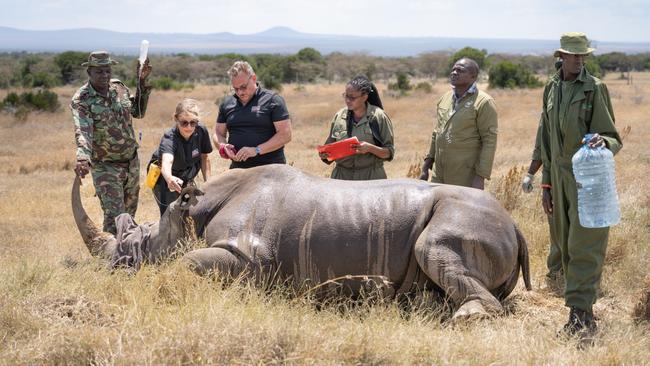IVF bid to save northern white rhino from extinction
Early success in a close subspecies raises hope for the critically endangered animals.

Scientists have achieved the world’s first rhinoceros pregnancy through IVF in a development that has raised hopes of saving the most endangered mammal on the planet from extinction.
The last two northern white rhinos, a mother and daughter, live under armed guard at Ol Pejeta Conservancy in Kenya, where in 2018 the death of the last male triggered an international scramble to prevent the species’ imminent extinction.
The procedure involved an international team of researchers transferring two laboratory-created southern white rhino embryos, a subspecies that can be considered a close cousin of the northern white, into a surrogate called Curra at Ol Pejeta in September. Satisfied the technique works, scientists want to repeat the process with northern white embryos. There are 30 stored in liquid nitrogen in labs in Germany and Italy that were created using eggs harvested from Fatu, the younger female, and sperm collected from two male northern white rhinos.
However, the project was devastated by heavy rains that flooded the surrogate’s enclosure and released a dormant Clostridia bacterium from the soil. Curra died from an infection 70 days into the pregnancy. The 6.4cm male foetus retrieved from her showed positive development and, the scientists said, a proof of concept.
“Witnessing the death of an animal you have worked with for so long for reasons that are beyond your control is depressing,” Frank Goritz, the BioRescue project’s head vet, said. “We try to take control of every factor that affects the wellbeing of the animals, but in nature you cannot control everything and sometimes your plans are thwarted by heavy rains and a disease. It is very sad, but we try to look forward and to see it as a milestone for the BioRescue mission.”
Two new surrogates named Arimet and Daly have been selected, and a “teaser bull” in the enclosure will signal when the female is at her peak for embryo implantation and gestation.
The last females, Najin, 34, and Fatu, 22, will not be risked with pregnancy, although scientists hope they will have a role to play.
Thomas Hildebrandt, head of the BioRescue project, said: “We want the offspring to live together with Najin and Fatu for years to learn the social behaviour of its kind. Although embryos can be stored in liquid nitrogen for a very long time, we are in a rush to bring a northern white rhino baby to the ground so they can learn the language from the last two rhinos; they can learn how to behave from them.”
Any births would all be from Fatu’s eggs – Najin’s were not viable – and the lack of genetic diversity could make it impossible to create a sustainable breeding population.
To address this, researchers are investigating the even more experimental technique of creating rhino sperm and eggs from stem cells to produce embryos.
The remains of Sudan, the last male northern white rhino, recently went on show in Nairobi, the Kenyan capital.
The Times



To join the conversation, please log in. Don't have an account? Register
Join the conversation, you are commenting as Logout